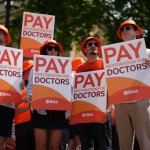Chancellor Rishi Sunak’s summer statement on July 8 was intended to show how the government can quickly end its emergency bankrolling of the economy, and let a re-energised private sector take the strain again. Since the lockdown was imposed in March, a furlough scheme has allowed shuttered firms to retain up to 9 million idled employees – over one-third of the workforce – at an Exchequer cost so far of £60 billion.
When the furlough scheme ends in October, Sunak has announced that it will be replaced by a £1,000 bonus for each employee retained until January 2021, at a maximum cost of £9 billion. There is also the addition of a £2 billion work-placement scheme, to open up jobs for the 700,000 school and university leavers unable to find one.
Amid a crisis that has highlighted the importance of public-sector workers, and could well trigger a deep recession, the government’s overwhelming concern is to prevent a jump in unemployment as the furlough scheme is wound down between August and October. The OECD is forecasting that the UK is heading for one of the highest rates in Europe – potentially rising fivefold to almost 15% if there is a second wave of coronavirus.
The OECD also forecasts in June that the UK could see a GDP decline of more than 11% for 2020, made worse by other industrial economies experiencing a similar slump. There had been hopes of a V-shaped UK recovery, spurred by an upbeat comment on May’s consumer-spending data by the Bank of England chief economist, Andy Haldane.
But the initial bounceback in sales may have been boosted by a one-off spree with the savings that people accumulated during lockdown. And if the V’s upward slope stops even slightly short of its downward slope, there will still be a painful shortfall in output and employment.
Big spender
The fact that the UK budget deficit is soaring, lifting total public debt above 100% of GDP for the first time since the early 1960s (when wartime debts were still being paid down). Yet the government’s judgement is that has to keep up the emergency spending, even as revenues fall sharply, until a firm recovery in production and employment is underway.
Indeed, the summer statement was notable for its continued focus on extra outlays – other new measures to boost the economy include a temporary VAT cut for the hospitality industry from 20% to 5% (costed at £4 billion), and a nine-month suspension of stamp duty on house purchases below £500,000 (removing at least another £1 billion in tax).
There is to be a Eat Out to Help Out scheme offering government-subsidised 50% discounts in restaurants in August, plus vouchers to help people pay to make their homes more energy efficient. The new measures add another £30 billion to the £175 billion of extra spending (and £130 billion of extra borrowing) announced in March.
As when Sunak announced the first round of government supports in March, the difficult task of raising taxes or cutting other expenditures to lessen the increase in the deficit has been left to the more detailed budget announcements due in the autumn – or even later.
The task of keeping people in work has been made more difficult by evidence that many firms were already “hoarding” labour before the pandemic, with some only staying in business because of record low interest rates. This was a reflection of over ten years of minimal growth in workforce productivity, which ground to a halt after the global financial crisis of 2007-09.
The new work placement scheme – paying employers for up to six months to take on young workers – has been likened to The Future Jobs Fund launched by Gordon Brown’s government after the financial crisis. A closer parallel may be the Youth Training Scheme with which the Thatcher government kept school leavers in jobs while all around them were losing theirs in the 1980-81 recession.
While Thatcher won re-election two years later with unemployment still around 3 million (over 10% of the workforce at that time) and rising, today’s Conservative government is keen to win over the largely anti-Brexit youth vote, and does not want to run the same risk.
Buy now, talk deficits later
Sunak’s “whatever it takes” growth-boosting contrasts sharply with the immediate spending restraint and tax increases that the Conservative-Liberal Democrat coalition deemed essential in 2010 after the financial crisis. Boris Johnson has already signalled there will be no return to “austerity”, even though the public debt to GDP ratio is now substantially higher than ten years ago.
This is partly a recognition of voters’ unwillingness to see the public sector cut again. It also reflects lingering doubt about whether austerity really worked, since it did not close the budget deficit by the 2015 target date (or even 2020), and may have left the health and social care services underprepared for COVID-19.
It also reflects an unprecedented confidence that the government can continue to run up new debt for some time, without the usual penalties of rising interest rates, higher inflation and a depreciating pound. Sunak isn’t necessarily a convert to the idea of modern monetary theorists that economists in the past exaggerated the constraints on public spending, underplaying governments’ capacity to borrow without squeezing resources from the private sector. But he’s realised it may be possible to keep spending and borrowing at near-zero cost for several more months (even years) to stimulate recovery, not least because so many other countries are having to do the same thing.
Alan Shipman ne travaille pas, ne conseille pas, ne possède pas de parts, ne reçoit pas de fonds d'une organisation qui pourrait tirer profit de cet article, et n'a déclaré aucune autre affiliation que son poste universitaire.










